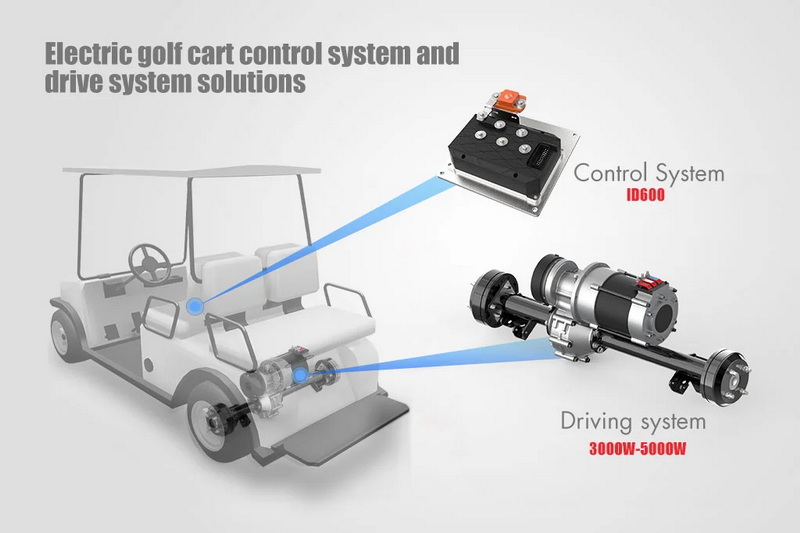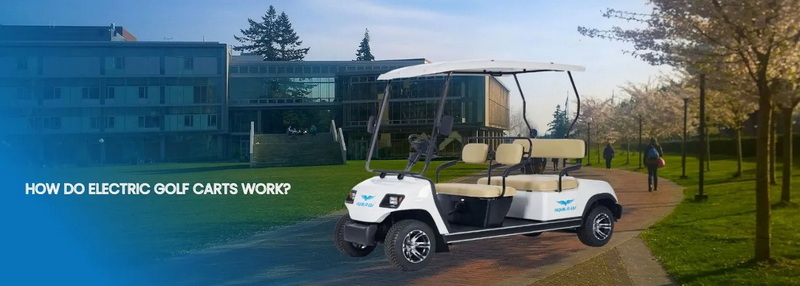Content Menu
● The Basics of Electric Golf Carts
● Key Components of an Electric Golf Cart
>> Batteries
>> Electric Motor
>> Controller
>> Accelerator Pedal
>> Braking System
>> Charger
● How an Electric Golf Cart Operates
● The Role of the Controller
● Battery Technology in Electric Golf Carts
>> Lead-Acid Batteries
>> Lithium-Ion Batteries
● Motor Types in Electric Golf Carts
>> DC Motors
>> AC Motors
● Regenerative Braking in Electric Golf Carts
● Charging an Electric Golf Cart
● Maintenance of Electric Golf Carts
● Environmental Benefits of Electric Golf Carts
● Future Trends in Electric Golf Cart Technology
● Conclusion
● Frequently Asked Questions (FAQ)
>> 1. How long does an electric golf cart battery last?
>> 2. What is the typical range of an electric golf cart?
>> 3. How long does it take to charge an electric golf cart?
>> 4. Are electric golf carts street legal?
>> 5. How do electric golf carts compare to gas-powered carts in terms of cost?
Electric golf carts have become increasingly popular in recent years, not only on golf courses but also in various other settings such as retirement communities, college campuses, and even some urban areas. These eco-friendly vehicles offer a quiet, efficient, and low-maintenance alternative to their gas-powered counterparts. In this comprehensive guide, we'll explore the inner workings of electric golf carts, their key components, and how they come together to provide a smooth and reliable ride.
 x
x
The Basics of Electric Golf Carts
Electric golf carts are battery-powered vehicles designed to transport golfers and their equipment around golf courses. However, their use has expanded beyond the fairways, and they are now commonly seen in various recreational and residential settings. These carts typically seat two to four passengers and can travel at speeds of up to 15-20 miles per hour.
Key Components of an Electric Golf Cart
To understand how an electric golf cart works, it's essential to familiarize yourself with its main components:
Batteries
The power source of an electric golf cart is its battery pack. Most golf carts use deep-cycle lead-acid batteries, although some newer models are equipped with lithium-ion batteries. These batteries are typically arranged in series to provide the necessary voltage, usually 36 or 48 volts.
Electric Motor
The electric motor is the heart of the golf cart's propulsion system. It converts electrical energy from the batteries into mechanical energy to drive the wheels. Golf carts commonly use either DC (Direct Current) or AC (Alternating Current) motors.
Controller
The controller acts as the brain of the electric golf cart. It regulates the flow of electricity from the batteries to the motor, controlling the cart's speed and direction.
Accelerator Pedal
The accelerator pedal, also known as the throttle, allows the driver to control the speed of the golf cart by adjusting the amount of power sent to the motor.
Braking System
Electric golf carts are equipped with a braking system that includes both mechanical brakes and regenerative braking. The latter helps to recharge the batteries during deceleration.
Charger
A built-in or external charger is used to replenish the battery pack when the golf cart is not in use.
How an Electric Golf Cart Operates
Now that we've covered the main components, let's dive into how an electric golf cart actually works:
1. Power Supply: When the golf cart is turned on, electrical energy from the battery pack is made available to the system.
2. Acceleration: As the driver presses the accelerator pedal, the controller receives a signal to increase power to the motor.
3. Motor Operation: The electric motor converts the electrical energy into mechanical energy, causing the motor shaft to rotate.
4. Power Transmission: The rotating motor shaft is connected to the golf cart's drivetrain, which transfers the power to the wheels.
5. Speed Control: The controller modulates the amount of power sent to the motor based on the position of the accelerator pedal, allowing for precise speed control.
6. Braking: When the brake pedal is applied, the controller cuts power to the motor, and the mechanical brakes engage to slow the cart down.
7. Regenerative Braking: During deceleration, the motor can act as a generator, converting some of the cart's kinetic energy back into electrical energy to recharge the batteries.
The Role of the Controller
The controller plays a crucial role in the operation of an electric golf cart. It performs several important functions:
- Speed Regulation: By adjusting the current and voltage supplied to the motor, the controller manages the cart's speed.
- Direction Control: The controller determines the direction of current flow to the motor, allowing the cart to move forward or reverse.
- Acceleration Management: It provides smooth acceleration by gradually increasing power to the motor when the accelerator is pressed.
- Regenerative Braking Control: During braking, the controller manages the regenerative braking process to capture energy and recharge the batteries.
- Battery Management: Some advanced controllers monitor battery health and optimize power usage to extend battery life.
Battery Technology in Electric Golf Carts
The battery pack is a critical component of an electric golf cart, as it determines the vehicle's range and performance. There are two main types of batteries used in golf carts:
Lead-Acid Batteries
Lead-acid batteries have been the standard in golf carts for many years. They are relatively inexpensive and reliable but have some drawbacks:
- Heavier than lithium-ion batteries
- Require regular maintenance (watering)
- Shorter lifespan compared to lithium-ion batteries
- Longer charging times
Lithium-Ion Batteries
Lithium-ion batteries are becoming increasingly popular in electric golf carts due to their numerous advantages:
- Lighter weight
- Longer lifespan
- Faster charging times
- Maintenance-free operation
- Better performance in cold weather
While lithium-ion batteries are more expensive upfront, their longer lifespan and improved performance often make them a cost-effective choice in the long run.

Motor Types in Electric Golf Carts
Electric golf carts typically use one of two types of motors:
DC Motors
DC motors have been the traditional choice for electric golf carts. They offer:
- Simple design and operation
- Good low-speed torque
- Easy speed control
- Lower cost
However, DC motors have some limitations, including:
- Less efficient than AC motors
- Require more maintenance due to brushes
- Limited top speed
AC Motors
AC motors are becoming more common in modern electric golf carts due to their advantages:
- Higher efficiency
- Longer lifespan
- Reduced maintenance (brushless design)
- Better performance at higher speeds
- More precise speed control
The main drawback of AC motors is their higher initial cost and the need for more complex controllers.
Regenerative Braking in Electric Golf Carts
Regenerative braking is an innovative feature in electric golf carts that helps to extend their range and improve overall efficiency. Here's how it works:
1. When the driver releases the accelerator or applies the brakes, the electric motor switches to generator mode.
2. The wheels' kinetic energy is used to turn the motor/generator.
3. This process generates electricity, which is fed back into the batteries.
4. The regenerative braking system also helps to slow down the cart, reducing wear on the mechanical brakes.
While regenerative braking doesn't recover all of the energy used during acceleration, it can significantly improve the cart's overall efficiency and range.
Charging an Electric Golf Cart
Proper charging is essential for maintaining the performance and longevity of an electric golf cart. Most golf carts come with a built-in charger, but some may require an external charger. Here's a typical charging process:
1. Park the golf cart in a well-ventilated area near a power outlet.
2. Turn off the golf cart and engage the parking brake.
3. Connect the charger to the golf cart's charging port.
4. Plug the charger into the power outlet.
5. The charger will automatically begin charging the batteries.
6. Once fully charged, the charger will typically switch to a maintenance mode to prevent overcharging.
It's important to follow the manufacturer's recommendations for charging frequency and duration to maximize battery life and performance.
Maintenance of Electric Golf Carts
While electric golf carts generally require less maintenance than their gas-powered counterparts, regular upkeep is still important to ensure optimal performance and longevity. Here are some key maintenance tasks:
1. Battery Maintenance: For lead-acid batteries, check water levels regularly and top up with distilled water as needed. Keep battery terminals clean and tight.
2. Tire Care: Check tire pressure regularly and inspect for wear or damage.
3. Brake Inspection: Periodically check brake pads and adjust as necessary.
4. Lubrication: Grease moving parts such as steering components and wheel bearings according to the manufacturer's schedule.
5. Electrical System Check: Inspect wiring connections and ensure all lights and signals are functioning properly.
6. Cleaning: Regularly clean the golf cart, paying special attention to the undercarriage to prevent corrosion.
Environmental Benefits of Electric Golf Carts
Electric golf carts offer several environmental advantages over their gas-powered counterparts:
- Zero Emissions: Electric golf carts produce no direct emissions during operation, helping to improve air quality.
- Reduced Noise Pollution: Electric motors are significantly quieter than gas engines, creating a more peaceful environment on golf courses and in residential areas.
- Energy Efficiency: Electric motors are more efficient at converting energy into motion compared to internal combustion engines.
- Renewable Energy Potential: Electric golf carts can be charged using renewable energy sources such as solar or wind power, further reducing their environmental impact.
Future Trends in Electric Golf Cart Technology
As technology continues to advance, we can expect to see several innovations in electric golf cart design and functionality:
- Improved Battery Technology: Ongoing developments in battery technology will likely lead to increased range and faster charging times.
- Solar Integration: Some manufacturers are exploring the integration of solar panels into golf cart roofs to supplement battery charging.
- Advanced Control Systems: Future golf carts may feature more sophisticated control systems, including regenerative braking optimization and terrain-adaptive power management.
- Connectivity Features: We may see increased integration of smart technologies, such as GPS navigation, smartphone connectivity, and even autonomous driving capabilities.
- Lightweight Materials: The use of advanced materials like carbon fiber could lead to lighter, more efficient golf carts with improved range and performance.
Conclusion
Electric golf carts represent a clean, efficient, and increasingly popular mode of transportation, not just on golf courses but in various other settings as well. By understanding how these vehicles work, from their battery-powered motors to their regenerative braking systems, we can better appreciate the technology that drives them and the benefits they offer.
As battery technology continues to improve and environmental concerns remain at the forefront, electric golf carts are likely to become even more prevalent and advanced in the coming years. Whether you're a golfer, a resident of a planned community, or simply interested in sustainable transportation options, electric golf carts offer a glimpse into a cleaner, quieter future of short-distance travel.

Frequently Asked Questions (FAQ)
1. How long does an electric golf cart battery last?
The lifespan of an electric golf cart battery depends on several factors, including the type of battery, usage patterns, and maintenance. On average:
- Lead-acid batteries typically last 4-6 years with proper care.
- Lithium-ion batteries can last 8-10 years or more.
Regular maintenance and proper charging habits can significantly extend battery life.
2. What is the typical range of an electric golf cart?
The range of an electric golf cart varies depending on factors such as battery capacity, terrain, and driving habits. Generally:
- Most electric golf carts can travel 15-25 miles on a single charge.
- Some high-end models with lithium-ion batteries can achieve ranges of up to 50 miles or more.
It's important to note that hilly terrain, frequent stops and starts, and carrying heavy loads can reduce the effective range.
3. How long does it take to charge an electric golf cart?
Charging time for an electric golf cart depends on the battery type, capacity, and the charger's output. Typically:
- Lead-acid batteries take 8-10 hours for a full charge.
- Lithium-ion batteries can charge in 2-4 hours with a compatible fast charger.
Some newer chargers offer quick-charge options that can provide a partial charge in a shorter time.
4. Are electric golf carts street legal?
The street legality of electric golf carts varies by location and the specific features of the cart. In general:
- Many communities allow low-speed vehicles (LSVs) on roads with speed limits of 35 mph or less.
- To be street legal, golf carts often need additional features such as headlights, taillights, turn signals, and seat belts.
Check local regulations to determine if and where electric golf carts can be legally operated on public roads.
5. How do electric golf carts compare to gas-powered carts in terms of cost?
When comparing the cost of electric and gas-powered golf carts:
- Electric carts generally have a higher upfront cost but lower operating expenses.
- Gas carts are often cheaper to purchase but have ongoing fuel and maintenance costs.
Over time, electric golf carts tend to be more cost-effective due to their lower energy costs and reduced maintenance requirements. The exact cost comparison will depend on factors such as usage patterns, local electricity rates, and gas prices.












 x
x




























